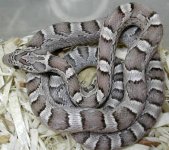I've said all I can on this to try to explain why I believe what I do in relation to this question, and I have no capacity to change anyone's mind ... let alone everyones' minds!

So, let me just say that I intend on following through pretty much as I have outlined earlier, because, in my opinion, it is the only option that makes any sense to me. People name things all the time for much less of a reason than I have set forth here, and we all just understand that "that guy" is wierd! LOL I'll suffer that burden, if need be.
All my babies, with the pattern mutation we have heretofore most commonly identified with the bloodred morph, that I produce will be identified as animals, which are "episkiastic." There is absolutley nothing untrue about that, because it is as honest a description of them as amelanistic, anerythristic, or hypomelanistic are for those animals. Whether anyone else describes those snakes in the same way or not, or whether that DESCRIPTION ever gets adopted as an actual name for the pattern mutation, I have no idea nor way to influence the outcome.
All of my line-bred, red epi corns will be listed as "bloodreds" pure and simple.
All epi corns homozygous for charcoal will simply be "pewters."
Just as soon as new names are coined for epi corns homozygous for lavender, carmel, anerythrism, amelansim, snow, amber, butter, ghost, phantom, and/or anything else, I will certainly adopt that name for that combination immediately.
I have never been too interested in naming or renaming a morph in all of this. I have only and always been interested in naming a pattern mutation we all know about, talk about, and can identify ... but have never named.
Thanks for the debate, everyone. It has been a lot of fun!!!


